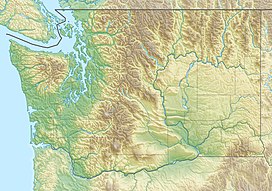geo.wikisort.org - Mountains
Ludden Peak is a 5,854-foot (1,784-metre) mountain summit located within Olympic National Park in Jefferson County of Washington state.[3] Ludden Peak is part of the Bailey Range, which is a subrange of the Olympic Mountains, and is set within the Daniel J. Evans Wilderness.[6] In clear weather, the mountain can be seen from the park's visitor center on Hurricane Ridge. The nearest higher neighbor is Mount Scott, one mile to the south-southeast, line parent Mount Ferry rises 1.6 mi (2.6 km) to the southwest, Dodger Point is 1.9 mi (3.1 km) to the northeast, and Stephen Peak is set 2.7 mi (4.3 km) to the northwest.[6] Precipitation runoff from the mountain drains into tributaries of the Elwha River.
| Ludden Peak | |
|---|---|
 North aspect (centered), from Hurricane Hill | |
| Highest point | |
| Elevation | 5,854 ft (1,784 m)[1] |
| Prominence | 694 ft (212 m)[1] |
| Parent peak | Mount Ferry (6,195 ft)[2] |
| Isolation | 1.16 mi (1.87 km)[2] |
| Coordinates | 47°51′22″N 123°32′25″W[3] |
| Naming | |
| Etymology | Addison "Doc" Ludden |
| Geography | |
| Location | Olympic National Park Jefferson County, Washington, US |
| Parent range | Olympic Mountains |
| Topo map | USGS Mount Queets |
| Geology | |
| Age of rock | Eocene |
| Type of rock | Metaconglomerate[4] |
| Climbing | |
| First ascent | Unknown[1] |
| Easiest route | class 2 via Dodger Point[5] |
Etymology
This peak was originally named "Mount Squire" by the 1889–90 Seattle Press Expedition after Watson Carvosso Squire, US Senator from the state of Washington. However, this geographical feature's name was officially adopted by the U.S. Board on Geographic Names to remember Addison "Doc" Ludden (1851–1927), an early pioneer of the Elwha Valley.[7] Ludden had a mining claim and cabin near the peak. He was buried at Ocean View Cemetery in Port Angeles, Washington.
Climate
Based on the Köppen climate classification, Ludden Peak is located in the marine west coast climate zone of western North America.[8] Most weather fronts originate in the Pacific Ocean, and travel east toward the Olympic Mountains. As fronts approach, they are forced upward by the peaks of the Olympic Range, causing them to drop their moisture in the form of rain or snowfall (Orographic lift). As a result, the Olympics experience high precipitation, especially during the winter months. During winter months, weather is usually cloudy, but, due to high pressure systems over the Pacific Ocean that intensify during summer months, there is often little or no cloud cover during the summer. The months June through October offer the most favorable weather for viewing and climbing.[1]
Geology
The Olympic Mountains are composed of obducted clastic wedge material and oceanic crust, primarily Eocene sandstone, turbidite, and basaltic oceanic crust.[9] The mountains were sculpted during the Pleistocene era by erosion and glaciers advancing and retreating multiple times. Ludden Peak is composed of hardened metaconglomerate.
Gallery
See also
- Olympic Mountains
- Geology of the Pacific Northwest
References
- "Ludden Peak - Climbers Guide to the Olympic Mountains". climbersguideolympics.com. Retrieved 2022-01-19.
- "Ludden Peak - 5,854' WA". listsofjohn.com. Retrieved 2022-01-18.
- "Ludden Peak". Geographic Names Information System. United States Geological Survey, United States Department of the Interior. Retrieved 2022-01-18.
- Daniel Mathews, 2021, Cascadia Revealed: A Guide to the Plants, Animals, and Geology of the Pacific Northwest Mountains, Timber Press, ISBN 9781643261010, page 531.
- Olympic Mountain Rescue, Climber's Guide to the Olympic Mountains, 1988, Mountaineers Books, ISBN 9780898861549, page 193.
- "Ludden Peak". Peakbagger.com.
- Parratt, Smitty (1984). Gods and Goblins: A Field Guide to Place Names of Olympic National Park (1st ed.).
- Peel, M. C.; Finlayson, B. L.; McMahon, T. A. (2007). "Updated world map of the Köppen−Geiger climate classification". Hydrol. Earth Syst. Sci. 11: 1633–1644. ISSN 1027-5606.
- Alt, D.D.; Hyndman, D.W. (1984). Roadside Geology of Washington. pp. 249–259. ISBN 0-87842-160-2.
External links
- Doc Ludden: photo
- "Olympic National Park". National Park Service.
- Weather forecast: Ludden Peak
- Doc Ludden's homestead in Elwha Valley: photo
- Doc Ludden's cabin: Wikimedia photo
Другой контент может иметь иную лицензию. Перед использованием материалов сайта WikiSort.org внимательно изучите правила лицензирования конкретных элементов наполнения сайта.
WikiSort.org - проект по пересортировке и дополнению контента Википедии



